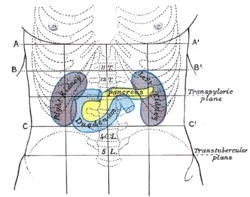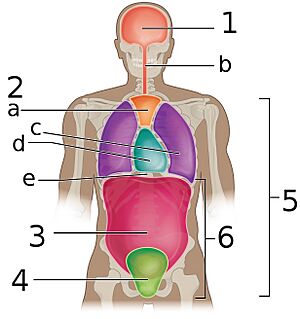Abdominal cavity facts for kids
Quick facts for kids Abdominal cavity |
|
|---|---|
 |
|
| Front of abdomen, showing surface markings for duodenum, pancreas, and kidneys. | |
| Latin | cavitas abdominis |
The abdominal cavity is a big space inside your body, found in humans and many animals. It holds many important organs. It's part of a larger area called the abdominopelvic cavity. You can find it just below your thoracic cavity (where your lungs and heart are) and above your pelvic cavity (where some reproductive and urinary organs are). The top of this cavity is a strong, dome-shaped muscle called the thoracic diaphragm, which helps you breathe. The bottom opens into your pelvis.
Contents
Inside Your Abdomen: Structure
Important Organs
The abdominal cavity is packed with vital organs. These include your stomach, liver, gallbladder, spleen, pancreas, small intestine, kidneys, large intestine, and adrenal glands. Each of these organs has a special job to keep your body working.
The Peritoneum: A Protective Lining
The inside of your abdominal cavity is covered by a special protective layer called the peritoneum. Think of it like a smooth, slippery bag. The part lining the inside wall is called the parietal peritoneum. The part covering the organs themselves is called the visceral peritoneum.
Between these two layers is a tiny space called the peritoneal cavity. This space contains a small amount of serous fluid. This fluid helps the organs move smoothly against each other. This is especially important for your gastrointestinal tract as it digests food. The peritoneum also helps hold the abdominal organs in place.
Some organs, like your kidneys, are actually located behind the peritoneum. This area is called the retroperitoneum.
Mesenteries: Holding Organs in Place
Mesenteries are special folds of the peritoneum. They attach organs to the walls of the abdomen. They also carry important blood vessels, nerves, and lymph channels to these organs.
Three important mesenteries are:
- The mesentery for the small intestine.
- The transverse mesocolon, which connects the back of the large intestine to the abdominal wall.
- The sigmoid mesocolon, which wraps around the sigmoid colon (part of the large intestine).
Omenta: Fatty Protective Folds
The omenta are another type of specialized peritoneal fold. They contain fat, nerves, blood vessels, and connective tissue. There are two main omenta:
- The greater omentum: This hangs down from the transverse colon and the lower curve of the stomach.
- The lesser omentum: This extends between the stomach and the liver.
What Can Go Wrong: Clinical Significance
Ascites: Fluid Buildup
Sometimes, extra fluid can collect in the abdominal cavity. This condition is called ascites. You might not notice it until a lot of fluid has built up, causing your abdomen to look swollen. This fluid can put pressure on your organs, blood vessels, and even your lungs. Doctors will try to find out why the fluid is collecting and treat the main cause. For example, if it's due to heart failure, treating the heart problem can help.
Peritonitis: Inflammation of the Lining
Another problem is peritonitis. This means the peritoneum (the lining of the abdominal cavity) becomes inflamed. It can happen if an organ is damaged, or if an infection gets into the cavity. Infections often come from the gastrointestinal tract.
Peritonitis can be sudden (acute) or long-lasting (chronic). It can affect a small area or spread throughout the whole cavity. The omenta can sometimes help to stop the infection from spreading. However, without treatment, the infection can become very serious. Doctors often use Antibiotics to fight the infection. Sometimes, an abscess (a pocket of pus) can form, and it might need to be drained.
See also
- Coelom


